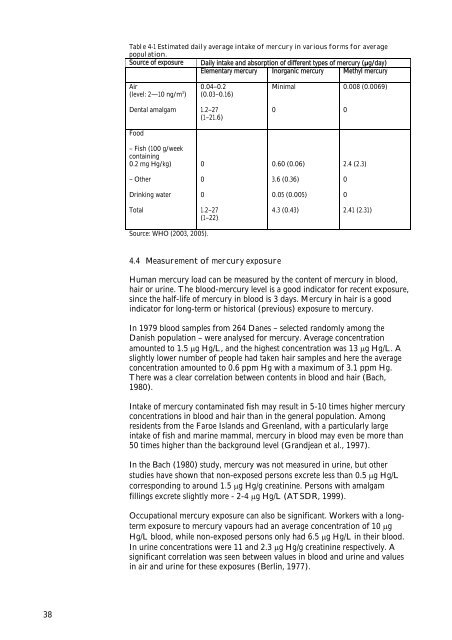No. 104 - Miljøstyrelsen
No. 104 - Miljøstyrelsen
No. 104 - Miljøstyrelsen
Create successful ePaper yourself
Turn your PDF publications into a flip-book with our unique Google optimized e-Paper software.
38<br />
Table 4-1 Estimated daily average intake of mercury in various forms for average<br />
population.<br />
Source of exposure Daily intake and absorption of different types of mercury (μg/day)<br />
Elementary mercury Inorganic mercury Methyl mercury<br />
Air<br />
(level: 2—10 ng/m 3 )<br />
Dental amalgam<br />
Food<br />
– Fish (100 g/week<br />
containing<br />
0.2 mg Hg/kg)<br />
– Other<br />
Drinking water<br />
Total<br />
Source: WHO (2003, 2005).<br />
0.04–0.2<br />
(0.03–0.16)<br />
1.2–27<br />
(1–21.6)<br />
0<br />
0<br />
0<br />
1.2–27<br />
(1–22)<br />
4.4 Measurement of mercury exposure<br />
Minimal<br />
0<br />
0.60 (0.06)<br />
3.6 (0.36)<br />
0.05 (0.005)<br />
4.3 (0.43)<br />
0.008 (0.0069)<br />
0<br />
2.4 (2.3)<br />
0<br />
0<br />
2.41 (2.31)<br />
Human mercury load can be measured by the content of mercury in blood,<br />
hair or urine. The blood-mercury level is a good indicator for recent exposure,<br />
since the half-life of mercury in blood is 3 days. Mercury in hair is a good<br />
indicator for long-term or historical (previous) exposure to mercury.<br />
In 1979 blood samples from 264 Danes – selected randomly among the<br />
Danish population – were analysed for mercury. Average concentration<br />
amounted to 1.5 �g Hg/L, and the highest concentration was 13 �g Hg/L. A<br />
slightly lower number of people had taken hair samples and here the average<br />
concentration amounted to 0.6 ppm Hg with a maximum of 3.1 ppm Hg.<br />
There was a clear correlation between contents in blood and hair (Bach,<br />
1980).<br />
Intake of mercury contaminated fish may result in 5-10 times higher mercury<br />
concentrations in blood and hair than in the general population. Among<br />
residents from the Faroe Islands and Greenland, with a particularly large<br />
intake of fish and marine mammal, mercury in blood may even be more than<br />
50 times higher than the background level (Grandjean et al., 1997).<br />
In the Bach (1980) study, mercury was not measured in urine, but other<br />
studies have shown that non-exposed persons excrete less than 0.5 �g Hg/L<br />
corresponding to around 1.5 �g Hg/g creatinine. Persons with amalgam<br />
fillings excrete slightly more - 2-4 �g Hg/L (ATSDR, 1999).<br />
Occupational mercury exposure can also be significant. Workers with a longterm<br />
exposure to mercury vapours had an average concentration of 10 �g<br />
Hg/L blood, while non-exposed persons only had 6.5 �g Hg/L in their blood.<br />
In urine concentrations were 11 and 2.3 �g Hg/g creatinine respectively. A<br />
significant correlation was seen between values in blood and urine and values<br />
in air and urine for these exposures (Berlin, 1977).

















